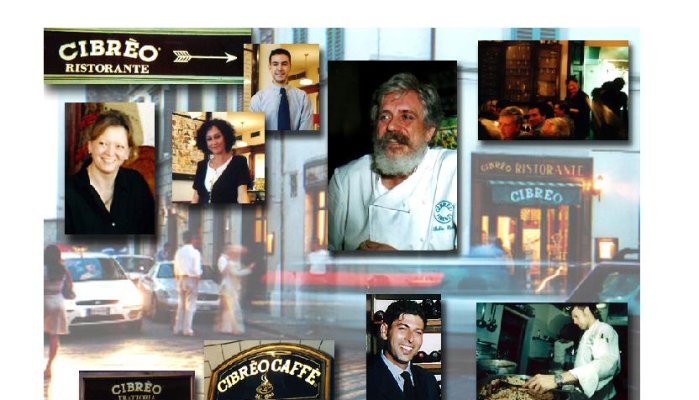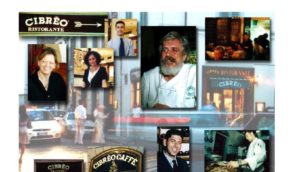
The Story of Cibrèo
Lessons Learned From Fabio
“I’m Your Chef, Not Your Mother.”
Coming Soon: The New Teatro del Sale alla Cibrèo Città
The Story of Cibrèo
Photography by Jim Andrew
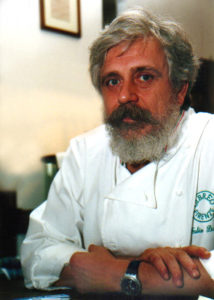 On September 8, 1979, Fabio Picchi at the age of 25 launched his restaurant, Cibrèo, on Via Andrea del Verrochio in the center of Florence near the San Ambrogio market. What was once a small local eatery with a tiny kitchen steadily grew into a world-renown elegant 80-seat venue with an expanded kitchen.
On September 8, 1979, Fabio Picchi at the age of 25 launched his restaurant, Cibrèo, on Via Andrea del Verrochio in the center of Florence near the San Ambrogio market. What was once a small local eatery with a tiny kitchen steadily grew into a world-renown elegant 80-seat venue with an expanded kitchen.
Along the way, Fabio’s operation sprouted into adjacent establishments. At the entrance of the restaurant is a small specialty food store which offers an assortment of wines, olive oil, dried porcini mushrooms, aged balsamic vinegar and other specialties as well as a little cookbook of the restaurant’s most requested recipes. Across the street is a bar, known as Cibrèo Caffè, which serves small meals. Finally, there is Cibrèo Trattoria known as the “sala dei poveri” (Italian for “the poor room”), which serves, for a much lower price, a smaller selection of the same food offered in the restaurant. Soon to come will be the Cibrèo theater, Teatro del Sale alla Cibrèo Città. Ironically, all of this developed much to the delight and surprise of his father, Eulio (also known as Enzo), who protectively and lovingly told his son when he opened the restaurant, “Failure is a good lesson in life.”
Whether Fabio ever learned the lessons that failure teaches, you’d have to ask him. He certainly doesn’t appear to have learned these lessons from taking on the daunting challenge of opening a restaurant in the heart of Florence. When he introduced Cibrèo to the Florentine dining arena, Fabio had a plan and he has stuck with it for twenty-three years. His objective has been to provide flavorful dishes to his customers that implant a savory memory not to be forgotten. Fabio appreciates quality flavors and he exhibits such awareness by serving dishes of Florentine and Tuscan traditional cuisine that have been prepared by Tuscan families for many centuries. Apart from his masterly flair and occasionally innovative alternations, his dishes are timeless and uncompromising to more modern tastes, preferences, and expectations.
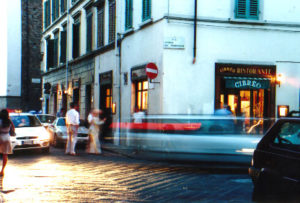 Today the flow of patrons never stops. For many, Cibrèo is a reference point for experiencing the full potential of traditional Tuscan cuisine. Locals, tourists, politicians, royalty and celebrities all flock to this landmark scene in Florence. Queen Beatrix came to eat pigeon. Catherine Deneuve came to have lunch with her daughter. Her visit put the incorrigible Fabio Picchi on his best behavior. “Let’s face it. A diva is a diva,” he said. “I remember the day she had lunch here and how I kept for my son the table cloth, a glass, the ashtray, and the cigarette stubs smoked by her. I have always banned my kids from bothering my customers for an autograph or other things. But on that occasion, I couldn’t resist. When she left, I made a little parcel of what she had left behind and I put it aside.”
Today the flow of patrons never stops. For many, Cibrèo is a reference point for experiencing the full potential of traditional Tuscan cuisine. Locals, tourists, politicians, royalty and celebrities all flock to this landmark scene in Florence. Queen Beatrix came to eat pigeon. Catherine Deneuve came to have lunch with her daughter. Her visit put the incorrigible Fabio Picchi on his best behavior. “Let’s face it. A diva is a diva,” he said. “I remember the day she had lunch here and how I kept for my son the table cloth, a glass, the ashtray, and the cigarette stubs smoked by her. I have always banned my kids from bothering my customers for an autograph or other things. But on that occasion, I couldn’t resist. When she left, I made a little parcel of what she had left behind and I put it aside.”
At times, Fabio has been pulled from his Santa Croce base to cook for heads of state dinners and other events around the world. On one occasion, he cooked for two former prime ministers of Italy who were dining together one night, Romano Prodi and Massimo d’Alema. “I still remember the exchange of glances between Prodi and d’Alema after the first taste,” Fabio said. “They seemed to be saying to each other, ‘This is good, isn’t it?’ At the end of the evening, I slipped away happy.”
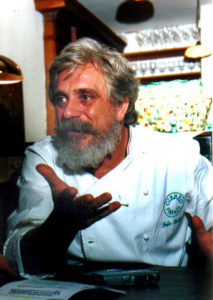 Fabio has strong cultural roots in cooking Tuscan cuisine. His mother’s cooking was a strong influence on him. He also would go on culinary adventures with his father all over Italy. He started his cooking performances at the age of seven when he made his first grilled eggplants with the help of his grandmother. There had always been good food in his family, they always ate well, and discussed food often. Growing up in Florence, he learned where to buy the best meat, the freshest fish and vegetables. He also learned where the best places to eat were in Florence. Such exposure to food allowed him to develop a talent for flavors. Because of his well-developed taste buds, Fabio believed he was destined to become a cook. “I remember when I was young, after school, I used to walk along the road practicing recognizing smells. Third floor – Livornese salted cod. First floor – rabbit. I sometimes ask myself how, over the years, I never got involved in drugs? I had other addictions, biting into a salami and fig sandwich for example.”
Fabio has strong cultural roots in cooking Tuscan cuisine. His mother’s cooking was a strong influence on him. He also would go on culinary adventures with his father all over Italy. He started his cooking performances at the age of seven when he made his first grilled eggplants with the help of his grandmother. There had always been good food in his family, they always ate well, and discussed food often. Growing up in Florence, he learned where to buy the best meat, the freshest fish and vegetables. He also learned where the best places to eat were in Florence. Such exposure to food allowed him to develop a talent for flavors. Because of his well-developed taste buds, Fabio believed he was destined to become a cook. “I remember when I was young, after school, I used to walk along the road practicing recognizing smells. Third floor – Livornese salted cod. First floor – rabbit. I sometimes ask myself how, over the years, I never got involved in drugs? I had other addictions, biting into a salami and fig sandwich for example.”
Making a reservation for dinner here is usually a necessity. During the high tourist season, sometimes it’s necessary to make a reservation two days in advance. The uninitiated patron will find the greeting of the staff at Cibrèo is impeccably polite. Upon entering the restaurant, you likely will be greeted by the maitre d’, Cristina Pedretti, or one of the head hosts, Francesca Agostini, or Moulay Achir. Once seated, one of the multi-lingual hosts will pour you a glass of white wine and then allow you to sit and absorb the ambiance of the dining room. Soon the person attending your table comes to pull up a chair to discuss the list of dishes. No menus are given out here. All of the first courses are set at the same price and the same is true for the second courses. This feature allows you to make your selection based on your taste and not your wallet.
The Cibrèo culinary experience begins with the waiters bringing an assortment of small portion antipasti to your table. These may include strips of trippa sautéed in olive oil and served with diced shallots, aged pecorino cheese and chopped walnuts tossed in olive oil with parsley and thyme, tomato aspic, and potato bread.

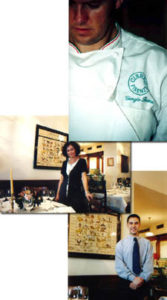
While you are enjoying your starters, Alfonso Bungaro, the sommelier who has worked at Cibrèo for the last sixteen years, will bring you the wine list and be available to answer any questions. He says that he tries to offer advice if required. He quickly gets a feel for the type of customer by paying attention to things like the way they look at the wine list or hold the wine glass. He understands if someone wants to impress their guests by picking an expensive wine without really knowing what it is or if they are knowledgeable enough to try certain wines. Having said this, Alfonso has noticed that people in recent years have begun to understand more about wine in general and Italian wines in particular. He believes that the image of the intimidating sommelier is outdated and it is his job to make people feel at ease and enjoy choosing wine in a relaxed atmosphere.
The choices for the first course may include a creamy polenta topped with a meat sauce, fricassea (lamb shoulder, or sometimes rabbit or chicken, in an egg-lemon based sauce), minestrone, ribollita (a twice-cooked hearty Tuscan soup of vegetables, and bread), baccalà (a dried salted cod) and his famous yellow pepper soup. Note, however, that no pasta is offered.
Second courses may include veal and ricotta croquettes served in a light tomato-basil sauce, steamed salmon scented with sage and rosemary, eggplant parmesan, stuffed chicken neck with homemade mayonnaise, stuffed roasted pigeon, veal hoof, sausage and beans, lamb’s brain in butter (a Turkish specialty which Fabio claims will be a Tuscan specialty in about two hundred years), shish kebab, and tuna carpaccio. Also, if you call ahead three days in advance, you can request the restaurant’s namesake, cibrèo, which is an ancient stew made with chicken giblets.
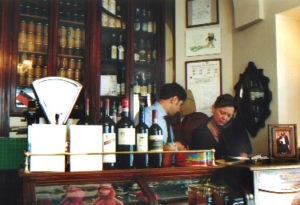
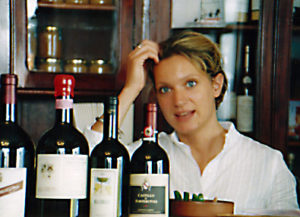 The choices for dessert may include panna cotta served with caramel sauce, mascarpone cheesecake baked with a bitter orange marmalade topping, a double-crusted pear tart with raisins, flourless chocolate cake, bavorese which is a molded custard served with strawberry sauce.
The choices for dessert may include panna cotta served with caramel sauce, mascarpone cheesecake baked with a bitter orange marmalade topping, a double-crusted pear tart with raisins, flourless chocolate cake, bavorese which is a molded custard served with strawberry sauce.
For each of the items offered at Cibrèo, you can bet that there is an interesting story behind it. For example, one of Fabio’s famous creations is his yellow pepper soup. Shortly after he had opened Cibrèo, Fabio was in Portoferraio on the island of Elba. He was walking past a house when he smelled several aromas that he could not recognize. His first impression was that it was squid, but he could not tell whether it was grilled or boiled. He knocked on the door and a little lady opened it. She explained that she was doing both. Her husband liked it grilled and her son preferred it boiled. Fabio ended up eating at this lady’s house for nine days. She made a sweet pepper sauce for pasta that made a fateful impression on Fabio. He took her recipe and transformed it into a soup.
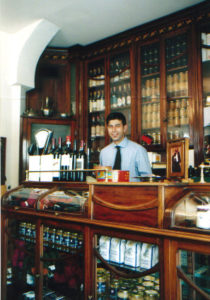 There is also a story behind the most obvious item that is not offered at Cibrèo: pasta. At the time when Fabio opened Cibrèo, he only had a tiny kitchen with a log-burning stove. Such a stove would have been difficult to bring water to boil on top of it for pasta. So Fabio thought, why bother? Instead, he focused on another Tuscan culinary tradition: soups. Only occasionally will he serve pasta, and it’s an event even if it is simply spaghetti with tomato sauce.
There is also a story behind the most obvious item that is not offered at Cibrèo: pasta. At the time when Fabio opened Cibrèo, he only had a tiny kitchen with a log-burning stove. Such a stove would have been difficult to bring water to boil on top of it for pasta. So Fabio thought, why bother? Instead, he focused on another Tuscan culinary tradition: soups. Only occasionally will he serve pasta, and it’s an event even if it is simply spaghetti with tomato sauce.
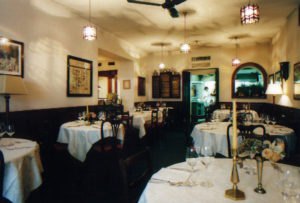
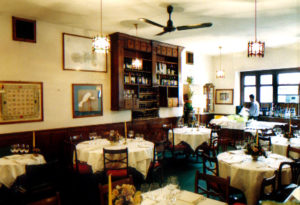
This is only a small insight into the life of Fabio and the world of Cibrèo. The walls of this establishment have seen so many stories to tell them all would require an investment of time equal to most people’s annual vacation time. Instead, if you haven’t already, you may want to use that time to visit Florence and make plans for your first Cibrèo experience. Then you may have your own story to tell someone about Cibrèo.
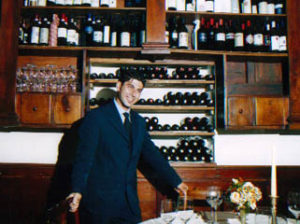
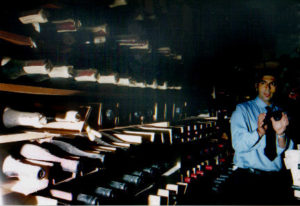


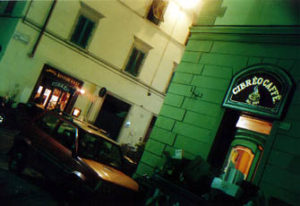
OOOOOOOOOOOOOO
Lessons Learned From Fabio
Photography by Jim Andrew
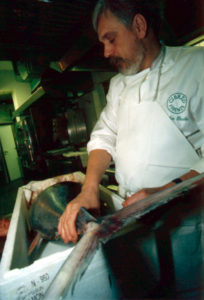 Fabio hates me. That’s what I was ready to conclude based on how bumpy things were going the Saturday morning I got to hang out with him in his kitchen. I assumed that I was there to interview him, have my photographer take photos, and Fabio was going to cooperate during the process. This was the structure I expected. Fabio, however, was not in a mood for this media nonsense which he has done for various publications many times before.
Fabio hates me. That’s what I was ready to conclude based on how bumpy things were going the Saturday morning I got to hang out with him in his kitchen. I assumed that I was there to interview him, have my photographer take photos, and Fabio was going to cooperate during the process. This was the structure I expected. Fabio, however, was not in a mood for this media nonsense which he has done for various publications many times before.
At first I thought — the way things seemed to be going — that this was going to be a disappointing and frustrating task. I wanted to end the session knowing that I got good answers from Fabio. That’s not exactly what happened and I thought the day was going to be a failure. But amazingly, I walked away with Fabio giving me something much more than I expected.
I showed up at Cibrèo with my photograph and my list of questions. I was ready to go. We found Fabio in a rather subdued mood. He greeted us outside his kitchen. An elderly gentleman was standing next to him.
“Good morning. This is my father, Enzo. Coffee?”
“Yes, please.”
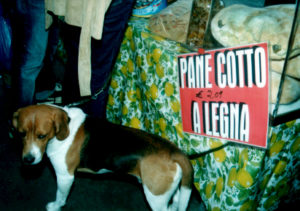
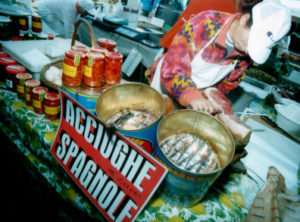
They took us across the small street to Cibrèo Caffè where Fabio ordered coffee for us. He started talking to a lady who was already having some coffee. This was his mother, Eliana.
We finished our coffee and Fabio asked if we were ready to go with him to the market. Jim and I were all set, but we had to pick up our equipment from a nearby table. We turned around to indicate to Fabio that we were ready, but he wasn’t in the caffè anymore. He was twenty yards down the street headed toward the San Ambrogio market.
“Fabio, wait!”
We caught up with him. Jim was scurrying to get into position to take some shots and I was fumbling through my list questions trying to find the market questions. Fabio appeared to be oblivious to our startled haste. I was waiting for him to perhaps give us some sort of running commentary about the overview of the market, what he looks for, maybe some anecdotes. He didn’t say a word. He just kept walking quietly through the market and not telling us where we were headed.”What are you looking for when you are selecting fish?” I open with.
“I saw this baccalà on Monday and I put it in water for one, two, three, five days.”
“Why did you do that?”
“I don’t know.”
Okaaaaay. Let’s try another question. “So Fabio. You have to come here to the market every morning more or less?” I looked up to listen to Fabio’s answer, but he was headed back to the entrance of the building where the fruit and vegetable stands were.
“Fabio, wait!”
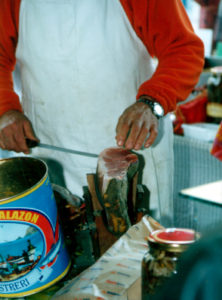
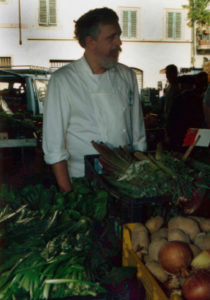
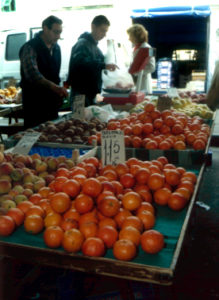
We caught up with him again. As he surveyed the stands, he explained, “This part of the market is from the central market and this part is from the countryside around Florence where the vegetables aren’t perfect. But the flavor!” He chit chatted with a few of the vendors and then said to me, “So … dried … water … small onion, small, ugly looking but good. There are already some Sardinian tomatoes that are deeper red. Then there’s the basil.”
“Fabio, I read in an article about you that you have 600 dishes to choose from. Is that true?”
“Maybe. I don’t know.”
Next question. “Were you born in Florence or Livorno?”
“Florence.”
“In Florence. Okay. You’ve got some Livornese blood in you, right?”
“Yes, my family. My family is from Livorno and Florence.”
“What part of Florence is your neighborhood? What part of Florence did you grow up in?”
“Here in Santa Croce!”
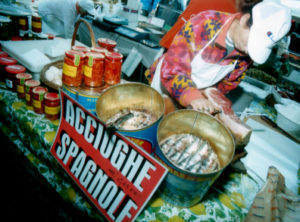
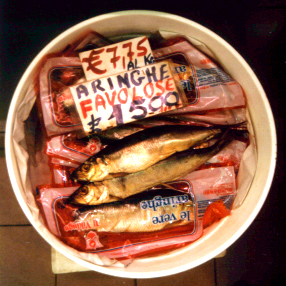
That was it for the market tour. We walked with Fabio back to his kitchen. He checked to make sure other items had been delivered and that everyone at their different stations in the kitchen were coming along okay with their work. He then inspected a half of a tuna that had been delivered and Jim began a discussion with Fabio about the fish.
“Where does this come from?”
“It comes from Elba or Sardinia. From the channel between the two.”
“It’s big!”
“Yes.”
“I’ve been sailing there.”
“Yes, around Elba you get them up to 400 kg.”
“I would’ve thought much less.”
“No, no!”
“Really! Are they caught with a line?”
“No, these are caught with a net.”
“Where do the fishing boats go from?”
“From Elba, Livorno, Piombino.”
“Is there a market nearby.”
“In Piombino, there’s a good market.”
“Really?”
“And in Marina del Campo on Elba.”
Fabio moved to another part of the kitchen to slice up the tuna that was delivered that morning. While he was busy carving, I walked into the dining room to get another cassette tape for my recorder. I came back to the kitchen and Fabio was upset about something. I saw him standing over a small pile of orange-colored spice on the floor.
“NO! Guys, this is like gold dust. Like gold dust.”
I asked Jim what was going on.
“Somebody dropped some saffron on the floor.”
I try another question. “Fabio. Are you the only chef in Florence who makes bread with potatoes?”
“I hope so.”
“Why did you choose to make the bread with potatoes?”
“I don’t know. I just tried it.”
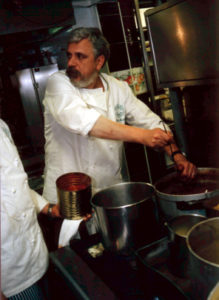 I was frustrated that my questions weren’t connecting with Fabio. I finally figured out what to do. Nothing. I tore up my list of questions and stopped worrying about questions and answers. Instead, I just stood near Fabio and watched him work. It was amazing what happened by just shutting up.
I was frustrated that my questions weren’t connecting with Fabio. I finally figured out what to do. Nothing. I tore up my list of questions and stopped worrying about questions and answers. Instead, I just stood near Fabio and watched him work. It was amazing what happened by just shutting up.
Fabio was busy with a phone call so there wasn’t much to watch him cooking at the moment. So I wandered through the kitchen and briefly stopped to observe what each person on his cooking staff was doing. There was a continuous stream of sounds. Chopping, sizzling, stirring, and bubbling. There wasn’t much talking, except when necessary.
I then walked out of the kitchen through the dining room up to the restaurant’s store in the front entrance. Francesca Agostini and Moulay Achir, two of the restaurant’s hosts, were preparing the silverware and setting tables. Cristina Pedretti, the maitre d’, was at the counter in the store taking reservations on the phone. Someone else was vacuuming.
I returned to the kitchen to find Fabio making one of his favorite dishes, eggplant parmesan. What struck me most was his calmness about the whole process. He would placidly place a layer of eggplant, then tomatoes, parmesan, and mozzarella. Then he pressed the layers down into the pan with his hands. Next, he would repeat this process at least four more times.
There were many other projects going on in the kitchen. Fabio was making sure that everyone did their jobs correctly, but he was calm about it all. He seemed to trust his staff’s capabilities to be left on their own. Every once in a while, he would check with different staff members about their assignments.
“Yellow pepper soup. How’s it going?”
“It’s all ready.”
“Put in the stock.”
“Mara. Have you made the coffee?”
“No.”
“Go and make it. Go on.”
“Couldn’t you find a better station on the radio?”
“Like what?”
“I don’t know. The news or something.”
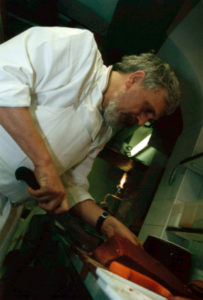
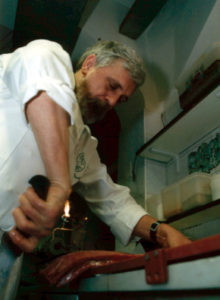
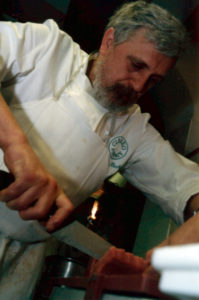
I could hear the sound of radio stations changing over the speakers. “We’re getting there.” Soon a song came on the radio that Fabio approved. It was the Beatles’ Across the Universe.
“Francesca, listen to what song it is.”
“I heard,” she responded as she walked out of the kitchen and into the dining room. Soon Fabio was humming in his heavy baritone voice with Lennon as he stirred his yellow pepper soup.
Words are flowing out like endless rain into a paper cup,
They slither while they pass, they slip away across the universe.
Pools of sorrow, waves of joy are drifting through my opened mind,
Possessing and caressing me.
Jai guru deva – om.
Nothing’s gonna change my world,
Nothing’s gonna change my world …
Cristina walked in the kitchen to show Fabio how the reservations were developing for this particular Saturday night. She showed him the groups of people who would be arriving and where she placed them on the seating chart. Fabio counted up the total.
“62, 70, 74, 80, 90, 99! Good!”
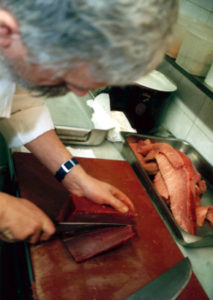
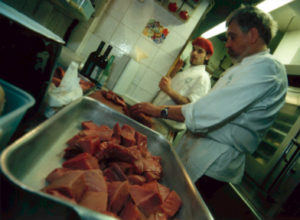 At 12 noon, Fabio began the obligatory tasting ritual. This is the most important moment of the morning, the moment of truth, when everything that has been cooked is tasted. This is to correct any mistakes. The whole cooking team must be present and take note of the results. “It’s great, but at the same time, tiring because it is repeated everyday and whether they like it or not, it’s part of the job,” said Fabio. Everyone working on different dishes made final preparations for the tasting. Fabio asked for a bottle of water to rinse between tastings. He and his first chef, Giorgio Busca, taste everything together and compare their reactions. The confidence that Fabio has in Giorgio is clear.
At 12 noon, Fabio began the obligatory tasting ritual. This is the most important moment of the morning, the moment of truth, when everything that has been cooked is tasted. This is to correct any mistakes. The whole cooking team must be present and take note of the results. “It’s great, but at the same time, tiring because it is repeated everyday and whether they like it or not, it’s part of the job,” said Fabio. Everyone working on different dishes made final preparations for the tasting. Fabio asked for a bottle of water to rinse between tastings. He and his first chef, Giorgio Busca, taste everything together and compare their reactions. The confidence that Fabio has in Giorgio is clear.
“Giorgio was born in Alba on a thick foggy morning,” Fabio said. “He has an impenetrable face, but if you move the leaves away from underfoot as you would near a large tree, you will find powerful roots.”
“Giorgio, did you add some more salt in just now?”
“In what?”
“In the soup.”
“No.”
“It needs a bit.”
“The salad. Stir it and then taste it, please. Did you put oil on the bread?”
“Yes.”
“The pepper soup needs stirring. Great. Then let me taste the bread. And will you taste the tripe, Giorgio? Salt, right?”
“Still hasn’t got vinegar.”
“The vinegar’s here.”
“Well done! Today, we’re really having a lucky day.”
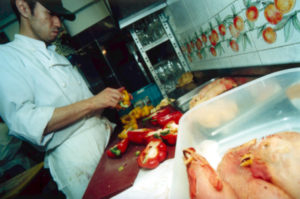

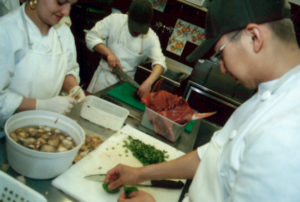
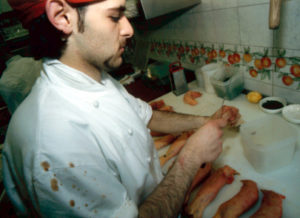
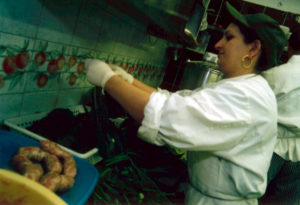
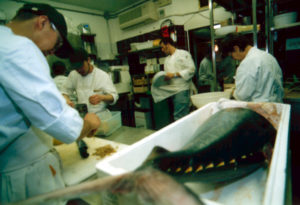
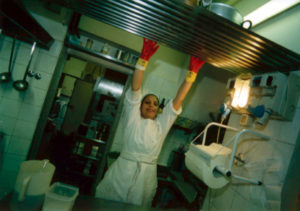

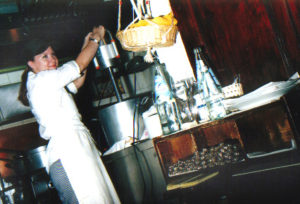
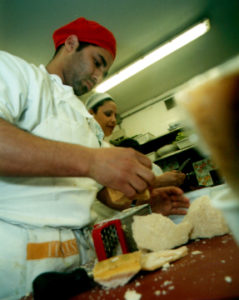
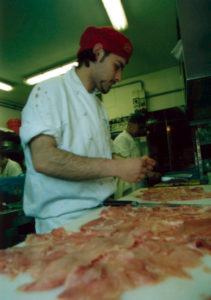
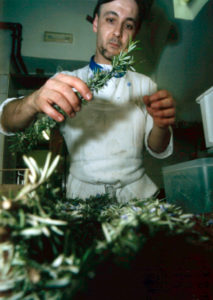
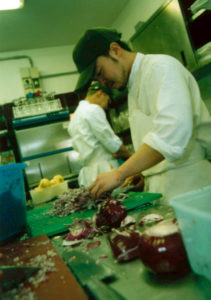
As everything looked like it was coming into place before lunch, Fabio took a break. Someone put on a tape recording on the stereo of Fabio on a radio show that was aired the previous week. He and the staff were amused by his tongue and cheek responses to the radio host’s questions.
HOST: So what about French cuisine, Maestro? It’s considered worldwide as one of the best cuisines.
FABIO: What! But this is rubbish. It’s something that people repeat without thinking about. French cooking is 400 years behind the times compared with Italian cuisine. They have some of the best restaurants in the world because they were the first to start in the restaurant business, but they don’t have a cuisine that’s of any interest to us. After a few days of being in France, your liver will be playing up with all those creams and sauces then it’ll be shouting: “Just give me a little salad!” However, 25 hours later your liver will be crying out again, “Give me some spaghetti with tomato and basil sauce, eggplant parmigiana and genovese soup.” Get it? You can’t stand any more of it. They’re a bit … it’s not interesting. French cuisine is a bit like the cuisine from Pisa. I’m only joking. We love you really, Pisa.
HOST: Listen, what do you think about Arezzo cuisine?
FABIO: I don’t know anything about it. To be honest, I hardly know anyone from Arezzo.
HOST: Aren’t they part of ethnic Tuscany as defined by the press? Why are you looking at me like that? They’re definitions that I’ve taken from the best food critics and you get offended.
FABIO: No, I’m not offended. This story of ethnic Tuscany is true but I don’t know anything about Arezzo.
HOST: You need to go to Arezzo, Maestro. So tomorrow we’ll both go to Arezzo in your car and we’ll go to try out the food and to have a look around. Yes?
FABIO: That sounds like a great idea. Okay. Next Saturday and Sunday I’ll talk to you about the cuisine in Arezzo.
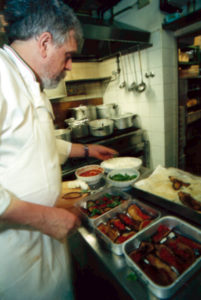
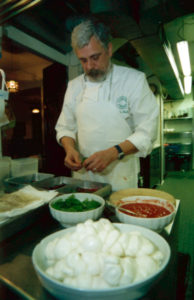
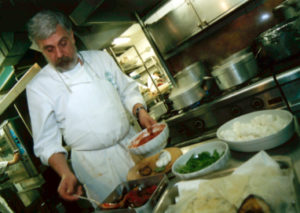
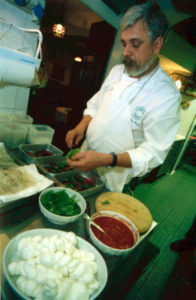
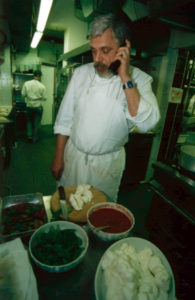
Taking in all of this activity caused me to reflect on some remarks Fabio has made in the past. I focused on three themes that he values: the importance of attention and repetition in cooking, the virtues of simple dishes, and the therapeutic benefit of cooking.
To cook well Fabio believes that the same amount of care, attention, and sensitivity should go into each dish that is prepared. Almost everything he cooks is cooked slowly and lovingly. He gives credit to women for overall being better cooks than men because he believes women understand how to add love to their food. “Women are great at day to day repetition, one of the most important principles of cooking.”
Fabio teaches his cooks to embrace the monotony of cooking. He urges them to repeat different routines for months until they become a habit. When preparing rabbit, Fabio said, “To stuff this rabbit you need sausage, the rind of lemon, sage, rosemary, beef, bread, milk, nutmeg and parmesan. But most of all is love. If you make the stuffing everyday, you will certainly end up bored by it, at least until you begin to love your job. Then you will do better, you will become a maestro who has the knowledge of how to use every ingredient at your fingertips. To work on and transform anything as and when you like.”
Although he has achieved world prominence as a master chef, Fabio doesn’t overlook the valuable pleasures from simplicity in cooking. “It doesn’t take much time and is better and tastier. Two-egg omelette with pesto and cous cous. Pasta with a little oil or butter and some grated parmesan. Mixed raw vegetables to dip in olive oil. A fruit salad can be incredible if it is lovingly made.”
He has talked about the importance of having the right attitude when cooking. “In front of the stove, nerves are disastrous. You can tell food that has been cooked by someone who is nervous straight away. Cooking is also therapeutic: if you are anxious while you are doing it, you’re not approaching it in a calm way and/or perhaps you are not actually able to do it very well. So instead of driving yourself crazy, when you invite people to dinner, instead of putting stuffed parrot’s tongue on the menu, give them bread and olive oil. Good oil and bread that you baked yourself.”
He gave an example of the therapeutic value of cooking. “Bread making, for example, is an age-old tradition that comes from the center of the brain. Try making bread and discover as you watch it rising and cooking, that you are moved. The action naturally caresses your neck and the sensation then gently flows through the rest of your body. Making bread makes you feel good. How come? Try it and see. You could save a fortune in therapy. You can make bread in the oven at home. If you don’t succeed the first time, try again, adjust the recipe, take something away, add something.”
A final thought on the act of cooking is that I do believe there is one intrinsic joy that always results from this activity. That would be the rewarding feeling of generosity. The joy you experience from sharing what you’ve made with family and friends. I dare say that Mr. Picchi takes pleasure from being hospitable as was evident when Jim and I wrapped up our work that Saturday morning.
“Fabio, we’re finished. Thank you for your time.”
“Finished?”
“Yes.”
“Do you want to eat?”
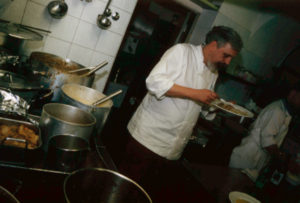
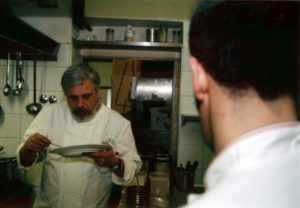
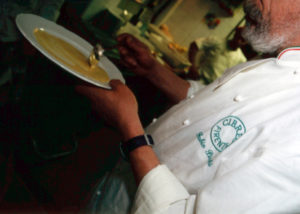
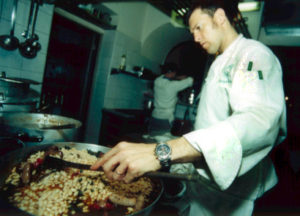
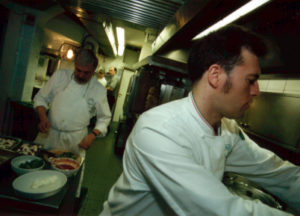
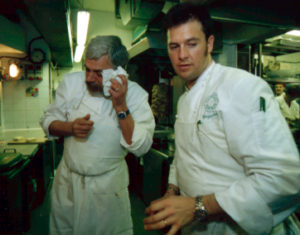
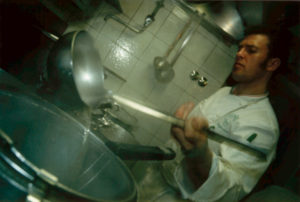
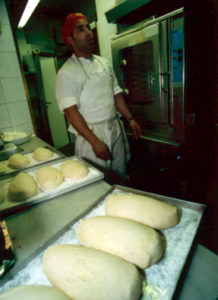
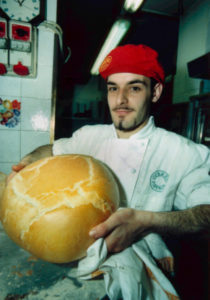
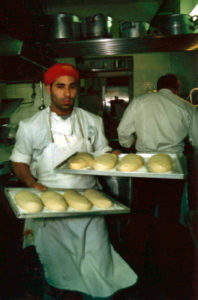
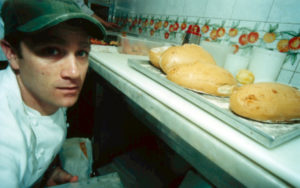
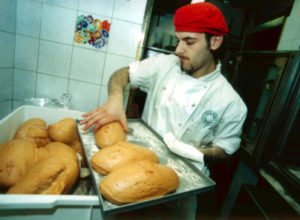
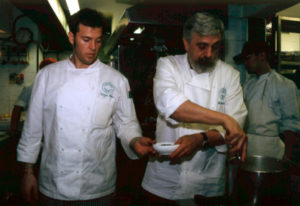
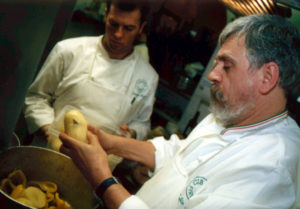
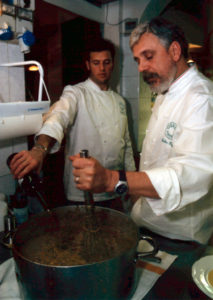
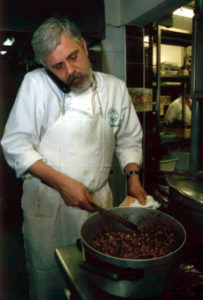
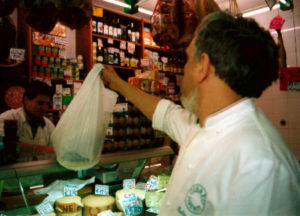
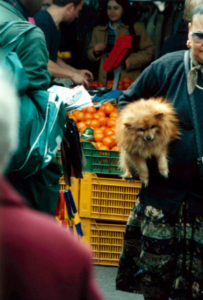
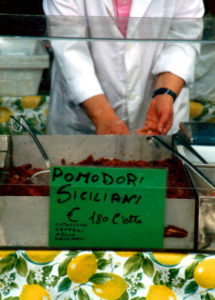
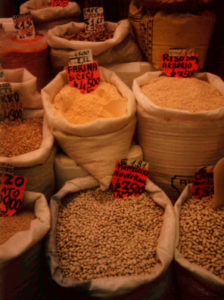
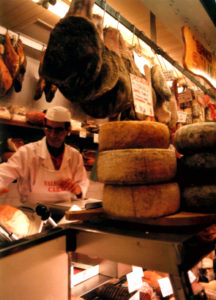
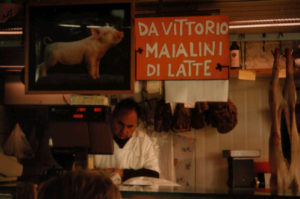
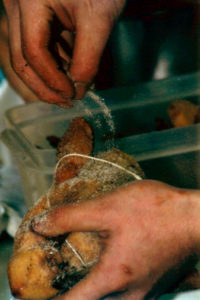
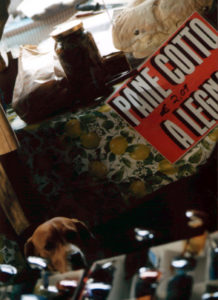
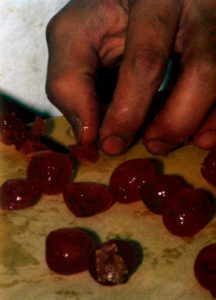
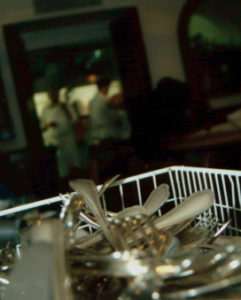
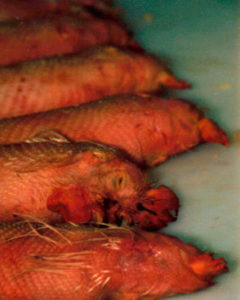
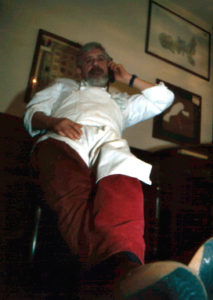
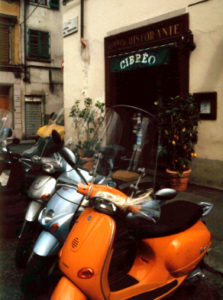
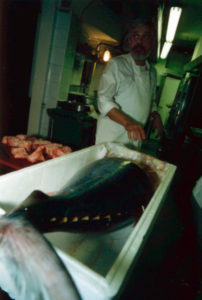
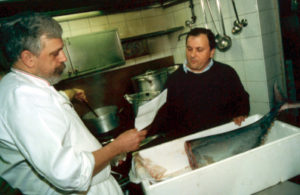
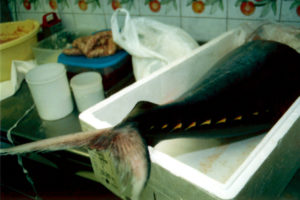
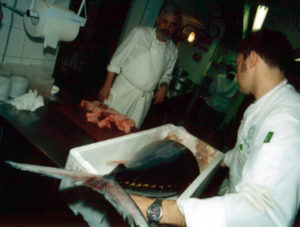
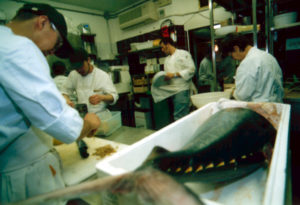
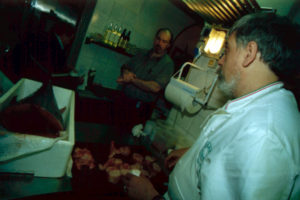
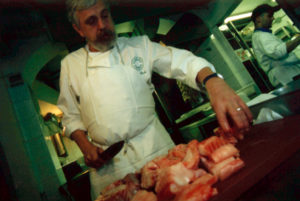
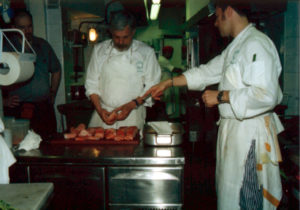
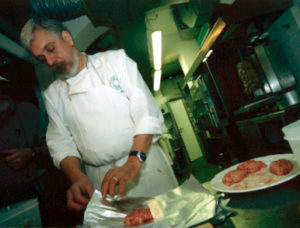

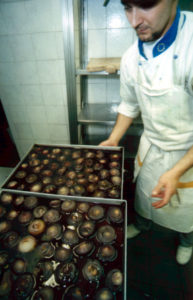

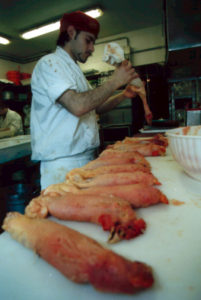
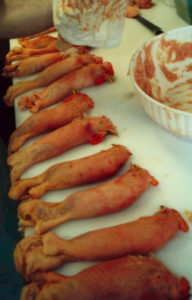
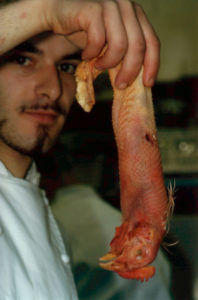
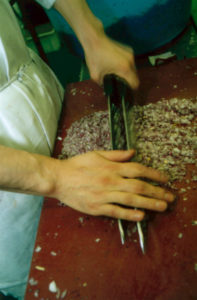

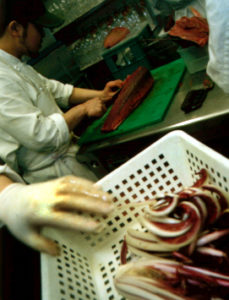
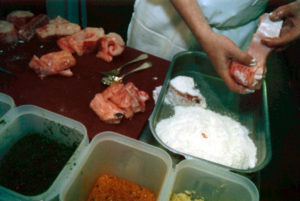
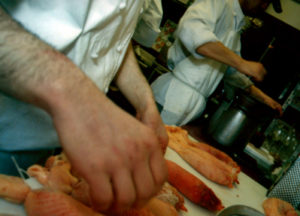
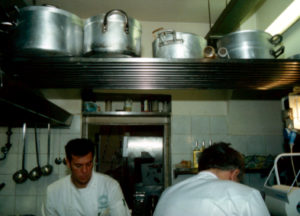
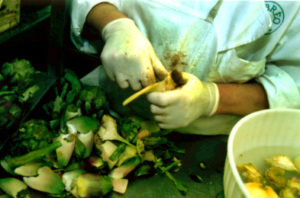
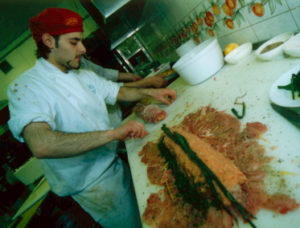
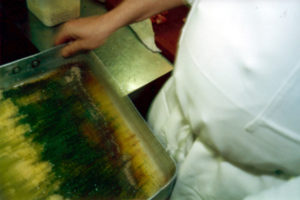
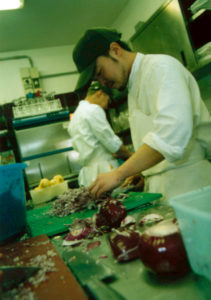
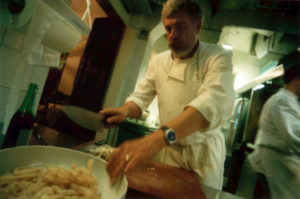
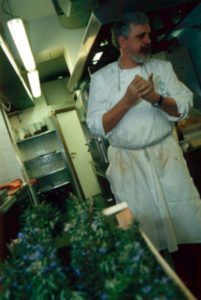
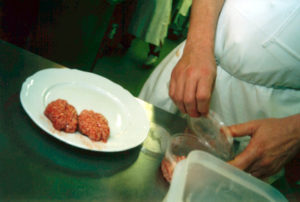

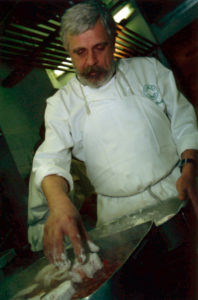
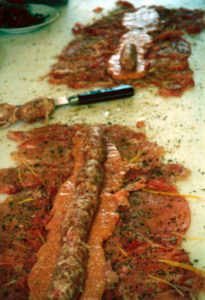
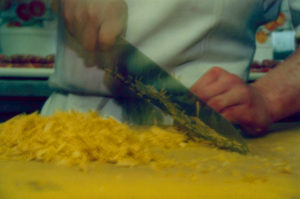
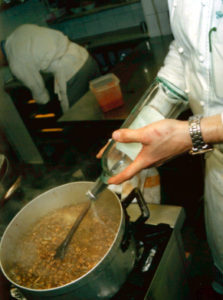
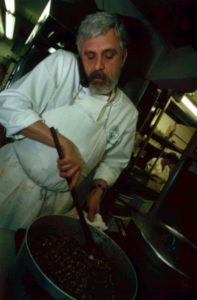
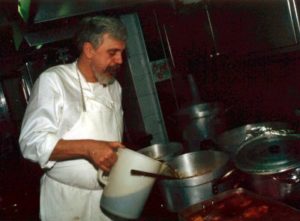
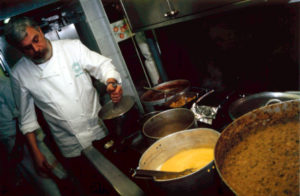
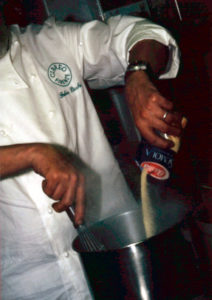
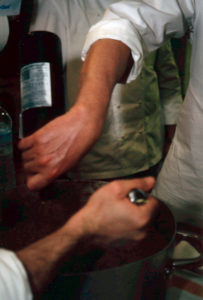
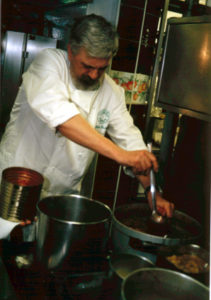
OOOOOOOOOOOO
“I’m Your Chef, Not Your Mother.”
Photography by Jim Andrew
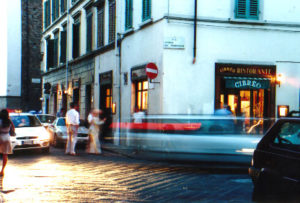 The walk was long from our hotel, Il Guelfo Bianco, on Via Cavour in the center of Florence to this restaurant, Cibrèo, next to the Sant’Ambrogio market in Santa Croce. Twenty minutes at least. The sky was now dark. This was my first full day in Italy ever. The restaurant where my family ate that night was highly recommended to us by two of our family members who brought us all here. My brother and sister-in-law had eaten here twice the year before while celebrating their tenth wedding anniversary. The only thing I knew about this place was that it was famous for not serving pasta. The first thing to strike me about the appearance of this famous establishment was its unassuming exterior. No flash. Low keyed. Welcoming. Warm. Elegant. Glad that you decided to have dinner with them. Once we entered through the stained-wood framed glass doors, the maitre d’ welcomed us in the small specialty food shop with wood panel floors. The next room brought us to the corner entrance to the rectangular dining room that flowed to our right to the kitchen doorway. We were seated to our table. Every table was occupied.
The walk was long from our hotel, Il Guelfo Bianco, on Via Cavour in the center of Florence to this restaurant, Cibrèo, next to the Sant’Ambrogio market in Santa Croce. Twenty minutes at least. The sky was now dark. This was my first full day in Italy ever. The restaurant where my family ate that night was highly recommended to us by two of our family members who brought us all here. My brother and sister-in-law had eaten here twice the year before while celebrating their tenth wedding anniversary. The only thing I knew about this place was that it was famous for not serving pasta. The first thing to strike me about the appearance of this famous establishment was its unassuming exterior. No flash. Low keyed. Welcoming. Warm. Elegant. Glad that you decided to have dinner with them. Once we entered through the stained-wood framed glass doors, the maitre d’ welcomed us in the small specialty food shop with wood panel floors. The next room brought us to the corner entrance to the rectangular dining room that flowed to our right to the kitchen doorway. We were seated to our table. Every table was occupied.
To this day, I can’t remember what I had to eat that night. I was absorbing too much on this vacation, my first time in Florence; in Tuscany; in Italy. Also, since this was just the beginning of my two-week vacation, I was thinking too much about all the other things I would do. I hadn’t stopped to notice what a remarkable restaurant I was in. I remember I enjoyed the food. The service was also as good as any other top restaurant in the western world I had been to.
My first specific memory of the restaurant was the chef, Fabio Picchi. I’ll admit it would be a couple of more years before I could actually remember his name. But what was unforgettable about the man was his presence – once I figured out which guy was the chef. It wasn’t obvious to me right away so I asked the waiter.
“You see the tall gray-haired guy with the beard over there wearing the apron?” she responded.
“You mean the Russian-looking guy who’s also wearing the stained white T-shirt, white shorts, white socks and tennis shoes?”
“Yes, that’s him.”
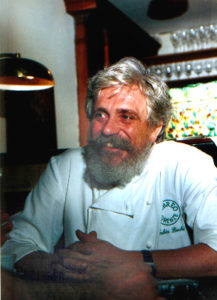 At that moment, Fabio was engaged in what appeared to be light-hearted conversation with an impressive looking group of people of about the same number of people as we had at our table. They also appeared to be a family. They were seated at the opposite end of the room near the entrance to the kitchen. Fabio was exchanging remarks with an attractive and regal woman at one end of the table who appeared to be the matriarch of the family. It turned out that this woman was VERY regal. It was Her Royal Majesty of Holland, Queen Beatrix. Only the second wealthiest woman in the world. No big deal. And she and the guy in the T-shirt and shorts were having an exchange of words like they were old friends. We learned from the waiter that the royal family was here to celebrate the birthday of her husband, Prince Claus.
At that moment, Fabio was engaged in what appeared to be light-hearted conversation with an impressive looking group of people of about the same number of people as we had at our table. They also appeared to be a family. They were seated at the opposite end of the room near the entrance to the kitchen. Fabio was exchanging remarks with an attractive and regal woman at one end of the table who appeared to be the matriarch of the family. It turned out that this woman was VERY regal. It was Her Royal Majesty of Holland, Queen Beatrix. Only the second wealthiest woman in the world. No big deal. And she and the guy in the T-shirt and shorts were having an exchange of words like they were old friends. We learned from the waiter that the royal family was here to celebrate the birthday of her husband, Prince Claus.
This wasn’t the Queen’s first visit to Cibrèo. The first time was when Queen Beatrix showed up informally. For her second course, she selected pigeon. Whenever someone orders pigeon, Fabio suggests that they eat it with their fingers so they don’t have to struggle with the small bones. However, with the Queen, he didn’t manage to tell her in time. Nevertheless, she did an exceptionally good job of cleaning the bones with the use of her utensils. Fabio was touched to see the Queen in his restaurant eating pigeon.
On another occasion, Fabio was the Queen’s wedding anniversary present to her husband. The Queen flew Fabio up to the royal palace to cook. What did he serve? The thing he’s famous for not serving. He cooked simple spaghetti in tomato sauce. He brought with him the best tomatoes, the most aromatic basil and Italian garlic (the type with the pink skin). As he tells it, “In the end, everyone got very emotional in front of that plate of spaghetti.”
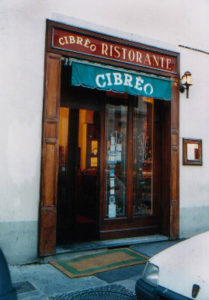 Getting back to that night in Florence, Fabio was constantly walking quickly through the restaurant making sure everything was in order at all the tables. But there was no serious or worried expression on his face. Everything appeared to be effortlessly under control. He was almost constantly grinning. Grinning as if he had just been told a good joke, as if he was enjoying the joke he was about to lightheartedly play on someone, or as if he were getting ready to pull somebody’s chain.
Getting back to that night in Florence, Fabio was constantly walking quickly through the restaurant making sure everything was in order at all the tables. But there was no serious or worried expression on his face. Everything appeared to be effortlessly under control. He was almost constantly grinning. Grinning as if he had just been told a good joke, as if he was enjoying the joke he was about to lightheartedly play on someone, or as if he were getting ready to pull somebody’s chain.
My father turned out to be Fabio’s next victim. I don’t remember what any of us had for dessert, but I do remember this unforgettable episode of having dessert. My father loved whipped cream. He ordered some sort of flat cake that did not have whipped cream on it. As Fabio was quickly walking from the front entrance to the kitchen, Dad called to him and asked if it were possible to have some whipped cream on his cake. Fabio replied, “No,” and continued his fast pace to the kitchen. Meanwhile, Dad was trying to figure out if Fabio really said “no” that definitively. He picked at his cake until he could hear Fabio’s deep voice coming closer as he walked back from the kitchen to the front entrance. Dad stopped him, “No really. I’d like some whipped cream on my dessert.” Fabio responded, “Really, no. I won’t let you.” You didn’t have to know my dad to see what the expression in his eyes said. “Did he really say no?” Whatever it was pulling Fabio back and forth between the front entrance and kitchen now required Fabio once more to pass by our table. This time my dad wanted an explanation. “Why can’t I have whipped cream on my dessert?” Fabio smiled and said, “Signore, I’m your chef, not your mother.” And he walked away. Dad made the best of it without the whipped cream.
At this point, let me try to explain something about this whipped cream situation that I don’t think is clear to all. First of all, to me there are two schools of thought on how customers feel they should be treated. There’s one group of restaurant goers who feel that a class restaurant should serve whatever the customer wants. The customer is paying for the meal so the restaurant should honor any reasonable request. The other group has a different approach. When they realize they are dining in the restaurant of a masterful chef and not of some hack or worse an overrated hack, they will sit back and trust the chef to cook however he pleases. They know they will benefit greatly.
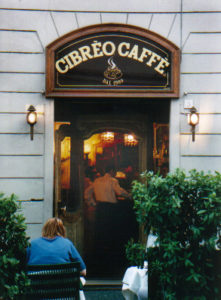 I suspect to the first group, Fabio’s behavior was outrageous. Who does this arrogant chef think he is, right? But wait. It’s a shame if this is one’s approach to this situation because the only one who loses is the customer. You think you’re going to stick it to Fabio by not returning to his restaurant? Wrong. The tables at Cibrèo will be full the next evening and the next and the next. No protesting “put-offed” customer or occasional hollow unimpressed (the nerve!) restaurant critic will sway the mass of those who know they are in good hands with Fabio to stop coming back. What one loses is the benefit of experiencing exceptional flavors and the emotions one experiences reacting to the sensations of those flavors. As you will see in the following articles, flavor combinations is a subject that Fabio has put considerable thought into and he doesn’t take this lightly.
I suspect to the first group, Fabio’s behavior was outrageous. Who does this arrogant chef think he is, right? But wait. It’s a shame if this is one’s approach to this situation because the only one who loses is the customer. You think you’re going to stick it to Fabio by not returning to his restaurant? Wrong. The tables at Cibrèo will be full the next evening and the next and the next. No protesting “put-offed” customer or occasional hollow unimpressed (the nerve!) restaurant critic will sway the mass of those who know they are in good hands with Fabio to stop coming back. What one loses is the benefit of experiencing exceptional flavors and the emotions one experiences reacting to the sensations of those flavors. As you will see in the following articles, flavor combinations is a subject that Fabio has put considerable thought into and he doesn’t take this lightly.
Now with my father, I don’t think he was genuinely annoyed with Fabio. Instead, I think he was just in shock that his request was refused. There was nothing in the tone of Fabio’s remarks to suggest he was being snotty or condescending to my father. His response was more in the tone of “No, I don’t think that would be a good idea. You will enjoy your dessert much more without the whipped cream.” Okay, you say, but “I’m your chef, not your mother?” That’s a bit harsh, isn’t it? Wait. Stay with me on this. You’ve just had the pleasure of meeting Signor Fabio Picchi. This is Fabio in full form. He likes to joke, pull your leg, or hit you with a zinger. I’ve learned that this is a good indication that he likes you. If he didn’t like you, he wouldn’t say anything to you. In fact, if Fabio didn’t like you, he’d probably get you the damn whipped cream without any remarks.
So this was not the end of the dessert episode or of Fabio and Dad’s relationship. One of the waiters left the dessert cart near our table, which had a big flat cake with confectioner sugar on top. It was also loaded with whipped cream. I just remember the cake was big and looked delicious. For all I knew at the time, it could have been a simple torta della nonna. It had already been cut. It was the birthday cake for Prince Claus. The cake was so big that slices had already been served to everyone at the Queen’s table and there was still more than half the cake left. My father couldn’t resist. The next time Fabio made his trip across the room, Dad asked him if he could have a piece. “Uh no, it’s for the Queen.” And Fabio walked away. As you might imagine, Cibrèo wasn’t probably going to be added to my father’s favorite restaurant list. The next thing we knew, Fabio came back with a slice of the Queen’s cake and swiftly placed it on the table in front of Dad. “Don’t tell anybody where you got that.” Fabio redeemed himself in my father’s eyes.
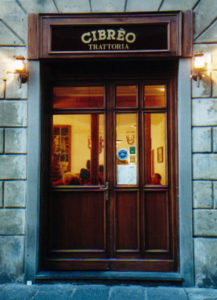
There was a final episode that illustrated to me how relaxed the attitude in this restaurant was. We were finishing our coffee. Most of the diners at the other tables, including the Queen’s family, had left. There was a white medium-sized dog sitting near the front door. So I turned my chair around and starting staring at the dog. She was looking around and eventually realized that I was staring at her. She had an expression on her face as though she was saying, “I beg your pardon.” I waved at her to come over to the table. She began to wag her tail, but she had a worried look on her face. By now, several of us were waving at her to come over to our table. Her tail wagged some more and she stood up, but she would not leave her spot. She had a worried expression on her face as though she were saying to us, “Guys, don’t tempt me like this. I’m going to get in big trouble if I come into the restaurant.” I couldn’t see what the harm would be so I kept waving at her to come over. She would look around the room to see if she would get the okay from somebody who worked there. Finally, one of the waiters indicated to her that she could go. She immediately trotted over to our table with an undeniable “doggy smile” on her face. When she got to the table, I gently patted her on the head. Soon half of us at the table were petting her. She seemed to enjoy all the attention. Her tail was rapidly wagging from side to side. Fabio walked by and we asked him to whom the dog belonged.
“She’s mine.”
“What’s her name?”
“Agata.”
That was the evening. Fantastic food. Attentive, friendly service. Fabio in his shorts and tennis shoes talking to the Queen of Holland. Fabio’s wit with a purpose. Making friends with Agata after dinner. That was five years ago, and we still talks about.
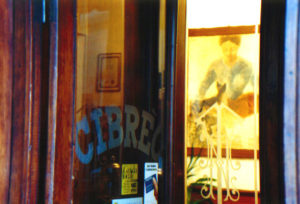
OOOOOOOO
Coming Soon: The New Teatro del Sale alla Cibrèo Città
Soon Fabio Picchi will open his new addition to what may some day be christened “Piazza Cibrèo” or “Piazza Picchi”. It will be a theatre located in the midst of his current three establishments — the restaurant, trattoria, and caffè. There will be an eclectic scope of performances. The theatre will house a reception area with a delicatessen shop that will sell only a few products. Also there will be a kitchen to serve meals before performances.
Here is what one might encounter as they enter Fabio’s new show. The building dates back to 1337. Just about all the furnishings have been hand picked by Fabio himself. The main entrance to the theatre will have a set of 19th century doors. Once inside the front door there will be a courtyard. Its floor will be made of the same stone used for the street outside. Near the entrance there will be benches and a strange type of large copper tank, like those that Tuscans have traditionally used to soak baccalà (dried salted cod), and it will have four or five little water jets coming out of it to form a fountain. Behind the tank on the wall there will be a slab of white marble like the marble used for tables. The slabs will go on the walls behind the copper tank fountain.
Beyond the fountain there will be a long counter and shelves for delicatessen products. The counter is from the 19th century that Fabio bought from the courthouse in Verona. Fabio found a whole 19th century grocer’s shop and he is bringing it all to the new theatre. The shop will have all wood and glass display cabinets. This will be mixed with English sofas. Ninety percent of the furnishings are from the 19th century. Most of the floors will be wood except one section that will be made of bits of marble, which is part of the original marble factory — the building’s original purpose.
Deeper inside the building will be a 1950s style kitchen, which will be visible to patrons. There will be a bread oven and a spit for roasting. The kitchen will have iron and glass gates. The idea is Tuscan style with a touch of English style. Part of the kitchen will have sort of an industrial workshop/kitchen feel. It will have wooden floors and iron like a scene from Charlie Chaplin’s “Modern Times.” Fabio hopes to have a vegetable garden in the terrace behind the kitchen. Food will be available for dinner but not seated. Instead, it will be a top quality buffet. Then, when everyone is finished they will go into the theatre. When the show is finished, they would come back to eat dessert and chat.
Once you are well inside, you will see a short hallway that leads to the theatre entrance. As you come to the next room through the hallway, on the left will be a private dining room identical to the one in the restaurant. But this one will be much bigger with a single table that seats 25 people.
On the right, will be the entrance to the theatre. The theatre will have 99 seats arranged around a huge stage. Theatrical events will only use half the stage. Another smaller stage will be built adjacent to the main stage for monologues. Seats may even be on the stage as well. Another feature of the theatre is that during the day you could have conventions, workshops, cooking classes, or acting classes.
There will be an international assortment of performances, not just Tuscan-related performances. Performances will be in Italian and other languages. There will be music, theatre, and comedy. Fabio has explained to all the theatres in Tuscany that he doesn’t want to be in competition with them. “We want to be a place that they can use, so we’ll have our own events, then other theatres will maybe use it for promotional purposes, for conferences, to do courses.” The two most important theatres, Teatro Comunale and La Pergola, are enthusiastic about the new venue. The artistic director is Fabio’s wife, Maria Cassi, who is an actress and director. Her contacts may help in bringing in performances from all over the world.
Choosing the name for the theatre took Fabio six months to decide. “I was with Faith Willinger and other friends. And I was saying, ‘What are we going to call this theatre?’ and everyone was chattering and Faith had brought me some salt and so this made a connection and I said, ‘I have it. Teatro del Sale.’ And Faith said, ‘Cibrèo Città.’ And I said, ‘Let’s have both.'”
Fabio has been working on this idea of a theatre for the past twenty years, but it has only been in the last four years that he started the process of making this happen. Teatro del Sale/Cibrèo Città is a logical choice as the next addition to Fabio’s already successful empire. Such an addition will magnify the theatre entertainment that has been an underlying buzz to the culinary sensations one experiences when dining at the restaurant or interacting with Fabio, the performer, entertainer, host, philosopher, and artist.

